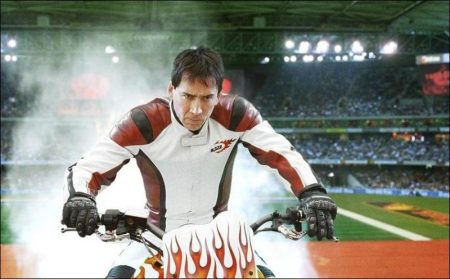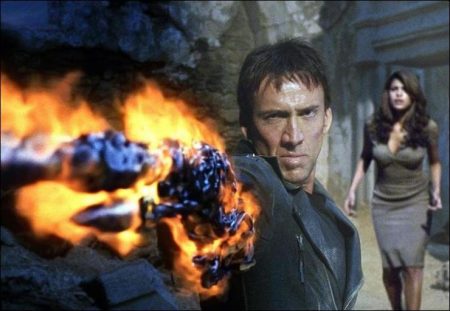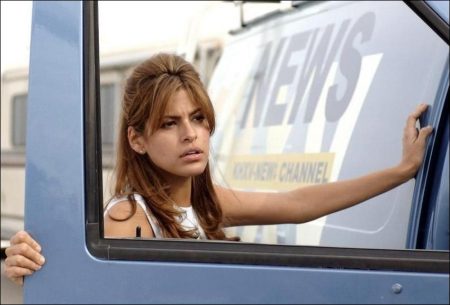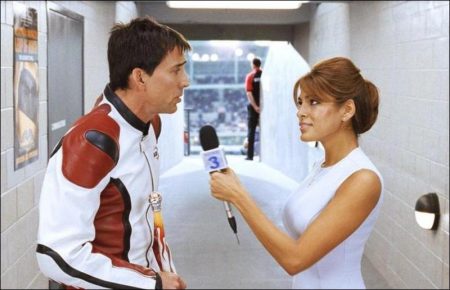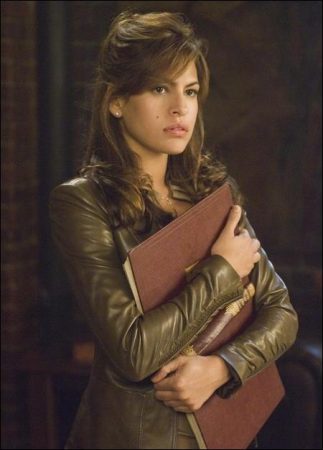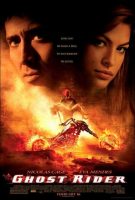Tagline: Long ago he made a deal to save someone he loved.
When the motorcyclist Johnny Blaze finds that his father Barton Blaze has a terminal cancer, he accepts a pact with the Mephistopheles, giving his soul for the health of his beloved father. But the devil deceives him, and Barton dies in a motorcycle accident during an exhibition. Johnny leaves the carnival, his town, his friends and his girlfriend Roxanne.
Years later Johnny Blaze becomes a famous motorcyclist, who risks his life in his shows, and he meets Roxanne again, now a TV reporter. However, Mephistopheles proposes Johnny to release his contract if he become the “Ghost Rider” and defeat his evil son Blackheart, who wants to possess one thousand evil souls and transform hell on earth.
Ghost Rider is a 2007 American supernatural horror superhero film written and directed by Mark Steven Johnson and based on the Marvel Comics character of the same name. The film stars Nicolas Cage as Ghost Rider/Johnny Blaze, with Eva Mendes, Wes Bentley, Sam Elliott, Donal Logue, Matt Long, and Peter Fonda in supporting roles.
Ghost Rider was released on February 16, 2007 in the United States by Columbia Pictures. The film was met with negative reviews from critics, but was a box office success, earning $228.7 million worldwide on a $110 million budget. Ghost Rider was released on DVD, Blu-ray and UMD on June 12, 2007. A sequel titled Ghost Rider: Spirit of Vengeance was released on February 17, 2012, with Cage reprising his role.
Ghost Rider was commercially released in the United States on February 16, 2007. The film grossed $15,420,123 on its opening day, while earning $45,388,836 for its opening weekend. The film earned $52,022,908 over the four-day President’s Day weekend, with a per-theater average of $US 14,374 in 3,619 theaters. The film’s total earnings were $228,738,393 worldwide of which $115,802,596 was from the North America.
About the Film
“I think Ghost Rider is one of the most unique mythologies in the comic book universe,” says Nicolas Cage, who brings the classic Marvel comic book character to life in Columbia Pictures’ Ghost Rider.
As the Devil’s bounty hunter, the Ghost Rider’s supernatural thrills are a perfect match for Cage’s intense and engaging persona. “He’s a complicated character who makes a decision to sell his soul to the Devil, but he does it out of love, not out of greed or personal ambition. To me, that is really rich material to play with. This scary-looking guy really is a hero.”
For director Mark Steven Johnson, who previously wrote and directed the hit comic-book adaptation Daredevil, bringing Ghost Rider to the big screen was the culmination of a lifelong love of the character. “I’ve been a huge comic-book fan from the time I was in third grade,” says Johnson. “I got comics every week: ‘Daredevil,’ ‘Spider-Man,’ ‘X-Men’ – all of them. ‘Ghost Rider’ was one of the most visually interesting, and, in my opinion, the coolest character.”
With such visually striking source material, Johnson was determined to make a creative and stylized film that did it justice. The result is a film that captures the arresting images of the comic book while it reinforces the moral choice forced upon the character. “The look of Ghost Rider was so amazing – it makes him one of the most memorable characters in the Marvel universe and can’t be improved upon,” he says. “It was our job to bring it to life. Our production designer, Kirk Petruccelli, and visual effects supervisor, Kevin Mack, were up to the challenge, and they have created a stylish world unlike any movie I’ve ever seen.”
The result is a film that represents the culmination of a search for the right team to adapt the comic book. “We’ve been trying to bring ‘Ghost Rider’ to the screen for a long time,” says producer and former Marvel CEO Avi Arad. “Just trying to catch the right tone, the right script. When I got Nic onto the project, it began to take shape. It’s incredibly gratifying to see a project through from initial casting to completion.”
Behind the camera, one of the first on board was producer Michael De Luca, who is also an ardent comic-book fan. As a young head of production for New Line Cinema, De Luca worked with Arad on the first movie adaptation of a Marvel property, the highly successful Blade, starring Wesley Snipes. Then, after the success of director Mark Steven Johnson’s adaptation of “Daredevil,” it was clear that the time was right to bring “Ghost Rider” to the screen.
According to De Luca, the character was in good hands. “When a writer-director like Mark is in creative control of the vision of the film, it’s an advantage in every way,” he says. “Mark loves comic books – he’s the perfect person to make the leap from the two-dimensional printed page to the three-dimensional movie screen. I think the character has always intrigued him because it’s so visual – the Ghost Rider is such an arresting image.”
“Obviously, Mark is a comic-book geek, but he’s also a sensitive guy who’s not afraid of emotion, which I think is hugely important in filmmaking in any genre,” says producer Gary Foster. “He has the enthusiasm he had as a kid and all the knowledge of someone who loves every detail and nuance of these characters.”
In addition to the visuals, the filmmakers were also attracted by the possibility of presenting a different kind of comic-book hero on the screen – one whose evil visage belies his good intentions and unique personality. According to Johnson, Nicolas Cage was the only actor who could pull off such a multi-faceted character. “I think the very best horror movies and thrillers are full of humor,” says the writer-director. “You need to release the tension. Having Nic Cage on board really cemented that, because he is naturally very funny. He took the character of Johnny Blaze and made him a lot more fun.”
De Luca adds: “In his search to make the character real, Nic acknowledges how outrageous his situation is: ‘I made a deal with the Devil and now I am a flaming skeleton on a motorcycle.’ You can’t help but discover the humor.”
“Once Nic was in the role, the humor came organically,” says producer Gary Foster. “As Nic plays him, he has a great sense of humor – which works well, because despite Johnny’s tough life, he still has the lightheartedness he had as a teenager.”
Johnson spent over a year crafting the script for Ghost Rider, which draws its character and storyline from multiple versions of the comic-book series. The “Ghost Rider” comic-book franchise started in the 1940s as a western-themed series about a gun-slinging horseman; it was later purchased by Marvel and reinvented in the 1970s as a supernatural story centering on motorcycle stunt rider Johnny Blaze. The property was revitalized again in the 1990s, again with a new lead character.
De Luca explains, “There was a certain amount of license because of the two incarnations of the comic book itself: the ‘70s version that I collected and remember, and then the ‘90s version. It changed so many times over the years that we were able to cherry-pick the parts we liked best.”
About the Production
Like the comic book series on which it is based, the film version of Ghost Rider combines humor and darkness with the western and superhero genres, as well as the world of motorcycle stunt riding. “I thought a supernatural western was a really cool idea and something I had never seen before,” says Johnson. “So I tried to take the best I could from the Sergio Leone films, like Once Upon a Time in the West and A Fistful of Dollars, and combine them with the aesthetics of the old classic Hammer Films horror movies.”
Producer Gary Foster notes that from the first moment, the filmmakers were committed to creating a striking film that lived up to the comic’s memorable imagery. “The film had to have a huge visual impact,” he says. “We wanted to make a film that wasn’t dark or edgy, but fun, and part of that is creating this very cool world.”
It fell to production designer Kirk Petruccelli to turn Johnson’s vision into a reality. Petruccelli – no stranger to the superhero milieu – has credits that include Blade, Lara Croft: Tomb Raider and its sequel, and even the superhero send-up Mystery Men. “Kirk is an amazing production designer,” says Johnson. “He created a whole look, a whole style that was totally unique. Each time we walked onto a new set, everyone in the cast and crew just stopped and stared.”
As he began plotting out the film’s overall look, Petruccelli says he turned first to the source material. “I tried to capture the spirit of the comic, which itself is so cinematic. What I pulled from it is how much power Ghost Rider has and the effect he and the other villains have on the environment. It is a very impactoriented comic. As a result there are very few thin, feminine lines. It’s more robust and hard-edged. And when someone is smashing into the ground, a car, or anything else, you have a major impact.”
Seeking a production venue that could credibly stand in for the wide-open vistas of the American high desert, as well as the seedy side streets and glass-and12 steel downtown of a contemporary western city, the filmmakers decided to shoot in Melbourne, Australia.
Foster says that it was one of Melbourne’s often-overlooked aspects that made it the perfect choice for Ghost Rider. “One of the reasons that we chose Melbourne was the city’s alleyways,” says Foster. “They were great – exactly what we needed. As for Melbourne itself – the central business district worked really well for us in creating a large Texas city. There was a huge amount of variety in Melbourne that allowed us to really play with the various locations.”
Adds executive producer E. Bennett Walsh: “All the places we filmed in the city were within a 20-block radius of each other, so it was very compact and very economical. Melbourne just seemed to fit and they were very open to us coming in to film there and made any filming we did on the streets very easy.”
The Australian port city and its environs gave Petruccelli plenty to work with as he created the world inhabited by Johnny Blaze and Ghost Rider. Among the notable locations was an ancient cemetery with a spectacular collection of headstones that served as the eerie home of Caretaker. “It was one of those rare, quite incredible locations,” says Petruccelli. “We actually changed the storyline a little to adopt it.”
Petruccelli and his team also used the Melbourne Showgrounds, whose old Victorian grandstand became the stadium for Johnny and Barton Blaze’s motorcycle stunt act.
For San Venganza, the isolated Mexican town where the climax of the film takes place, Petruccelli created a massive set: “It’s a town that’s been forgotten and has become the most vicious place on earth – hell on earth to be exact. So the design needed to reflect both decay and destruction.”
The man charged with capturing Petruccelli’s realization of Johnson’s vision was director of photography Russell Boyd ACS. Boyd says that one way the filmmakers kept the energy of the movie high was to keep the stationary camera shots to a minimum. “We kept it moving,” says Boyd, “and we used a lot of Steadicam with 360-degree rotations around the actors, particularly around Nic, when Johnny Blaze transforms into Ghost Rider.”
Boyd also used a system known as Spidercam, in which a camera is attached to an overhead cable on a stabilized mount, which allows for super-fast tracking shots. “For instance, when Johnny Blaze jumps his bike over the trucks in his show, we had Spidercam pull over about 30 huge trucks. It enabled us to recreate the move via computer control, so the action was absolutely perfect for each take. It’s also a great tool for the visual effects people to work with.”
In keeping with its comic-book roots, the film’s color is “more saturated than it would be normally, a little bit more colorful in a lot of areas,” says Boyd. Lighting-wise, the DP says that at Johnson’s suggestion he used a lot of what the director calls “dirty light.” “I’m using a lot of yellows and greens where Blackheart’s involved or Mephistopheles or the Hidden,” he says. “So it’s actually given me an opportunity to get a little bit messy with the lighting. When part of the love story is developing between Nic and Eva, we give that a warmer, more romantic feel.”
Of course, any superhero worth his powers needs an instantly recognizable costume. Early on in the pre-production process, costume designer Lizzy Gardiner decided to stay away from the traditional form-fitting Lycra look for Ghost Rider: “I really wanted to stay clear of that – the big shoulder line, the tiny waist, the skin-tight suit. I wanted to do something new and original.”
At the same time, Gardiner knew she had to walk a fine line between staying true to the comic-book character and creating a suit that worked well on film. So before she sewed a stitch, Gardiner immersed herself in the world of contemporary motorcycle clothing. “The whole approach with these suits is so scientific now, so mathematical,” she says. “The bikes are just so fast and the suits are almost futuristic.”
Johnny’s street clothes, on the other hand, are the opposite of flashy, says Gardiner: “We wanted to stay true to the fact that Johnny Blaze is obsessed with motorbikes and doesn’t really care about who he is when he is not on one. We tried to stay away from any kind of personal vanity. He still needs to look fantastic, but he also needs to look like he couldn’t care less about who he is, what he is, or what he is doing when he’s not on a bike.”
According to Johnson, Gardiner’s costumes formed a strong basis for the Hidden – three demons, fallen angels, who have aligned with Blackheart. “Their coats and shapes came from my love of westerns – the bad guys wearing those long dusters and attitude,” says Gardiner. “That was the look we started with, and then Lizzie’s challenge was to make it seem like their clothes were actually made of their element – of earth and water and wind – and I think she succeeded wonderfully.”
Playing with Fire: The Hellcycle & The Visual Effects
One of the biggest challenges Petruccelli and the rest of the crew faced was bringing to life the Hellcycle, Ghost Rider’s flaming ride. According to Arad, the Hellcycle will please even the most die-hard motorcycle fans – a group in which Arad includes himself. “Harley Davidsons are my hobby,” says the producer, who also owns the chain of Harley Davidson cafés. “The Hellcycle is a character – it has guts, soul, vertebrae, eyes, and sex appeal. Ultimately, it’s a piece of hardware, but out of it comes feeling and emotion.”
“Building the Hell bike was a colossal undertaking,” says the production designer. “In addition to being the most supernatural, kick-ass-looking bike that ever existed, it had to work. It had to be fast, it had to be powerful, and it had to be able to be handled.”
Johnson says his goal was to enhance the comic-book version of the Hellcycle. “I wanted it to be the coolest thing you’ve ever seen – cooler than the Batmobile,” he says. “It’s something between a machine and an animal, with bone structure, a spine and a huge personality. Crash McCreery, one of our artists, came up with the design and then it became a moving piece of art. It took on its own personality, just like the Ghost Rider.”
“We were aware that realizing the Hellcycle in three dimensions was going to be one of our greatest challenges,” says De Luca. “I thought they did an incredible job. It achieves everything that made the bike in the comics so great and even takes it further, with the skull on the front and the flaming tires. It’s like nothing you’ve seen before.”
Petruccelli toiled for months with a team of sculptors, painters, and motorcycle technicians to create the possessed motorcycle. “We started with a small maquette and then we went to the next stage, building real scale elements. Once the design was approved, seven individual bikes were produced. Each has a different function and all are custom-scaled and fit to Nic.”
Once the Hellcycle had been built and photographed, the torch was passed to the visual effects team. “Mark wanted to use a real bike and I encouraged that,” says visual effects supervisor Kevin Mack. “I think it’s good to have real elements where you can. Our work is most effective when it’s a mix – and then you really lose track of what’s CG and what’s real. There are, however, a few sequences where the bike is entirely computer generated and certainly the fire on it is always computer generated.”
For Mack, the creation of both the Hellcycle and Ghost Rider was literally a trial by fire. “Ghost Rider has a flaming head,” explains Mack. “He bursts into flame and turns into a skeleton. He rides a chopper that’s also on fire. So I would say the biggest challenge was to create fire in a very directable way that was completely realistic. For the simulation of the fire we did a great deal of research and gathered a lot of work that has been done in the academic community in terms of fluid flow dynamics – the simulation of fluids, of which fire is one. A lot of this work came from some equations called the Navier-Stokes equations, undertaken for scientific purposes. Some very clever people took those equations, simplified them a little, and started applying them to computer graphics. We took some of that work and implemented it into tools we could use.”
To help integrate the live shots of the Ghost Rider and Hellcycle with the CG fire added in postproduction, Mack and his team developed two interactive light rigs. For the Ghost Rider, the rig consisted of a sheer face mask mounted with flat, randomly flashing LEDs that cast light onto the actor’s shoulders to mimic reflections from the flaming head. The same approach was used on the Hellcycle, where LEDs attached to the wheels cast flickering light onto the ground as well as onto the bike itself.
“They really make the CG fire feel like it’s in the scene,” says Mack. The filmmakers also relied on digital effects to communicate Ghost Rider’s emotional state. Without the benefit of flesh and muscles to control facial expressions, the skull head could not convey feelings. So Mack and his team used a number of techniques to breathe life into the character. “In addition to subtle head movements and capturing the performance of the actor, we had to treat the fire as his main expressive element. Its color changes a little with each emotion,” says Mack. “We also used the heat distortion from the fire to warp the face a little, to cast shadows in subtle but effective ways to alter the expression. When he speaks, the breath disturbs the fire and that gives the effect of lips moving.”
“Kevin’s greatest challenge was to create fire in a unique way so we could manipulate it,” says Arad. “Because Ghost Rider is a supernatural being, he can use the flames around him – in a way, they’re how he emotes. The flames tell a story – this is not just ‘flick your Bic.’”
In addition to the flames, the Ghost Rider skull was designed so its expression could be manually adjusted between shots. “You will never see it change on camera, but from scene to scene we were able to make him look angrier or more sullen or whatever the situation required,” says Mack.
Mack describes the movie as a “visual effects feast.” Among his favorite sequences is the scene in which Johnny Blaze jumps his bike across a football field. While the stadium and one of the ramps were real, the arena was entirely empty, says Mack. “The bike, the rider, the spectators and the six Black Hawk helicopters he jumps are all computer generated.”
Another fully computer-generated scene was the one in which Ghost Rider and Caretaker race across the desert toward the final showdown with Blackheart. Regardless of whether a particular shot could best be produced using live effects, digital magic, or both, Mack says his ultimate goal was to create the most realistic image possible. “I wanted to be able to take the audience’s breath away with the imagery. The key for me was to see Ghost Rider in person, with a flaming skull, riding a chopper up and down skyscrapers, and to treat it like it was absolutely happening right in front of us. That’s what I think we all look for in a movie, regardless of the genre. You’re looking to be transported into that world, and have the characters be absolutely real for you.”
Ghost Rider (2007)
Directed by: Mark Steven Johnson
Starring: Nicolas Cage, Jon Voight, Wes Bentley, Eva Mendes, Matt Long, Sam Elliott, Peter Fonda, Donal Logue, Tony Ghosthawk, Hugh Sexton, Marcus Jones,Jessica Napier
Screenplay by: Mark Steven Johnson
Production Design by: Kirk M. Petruccelli
Cinematography by: Russell Boyd
Film Editing by: Richard Francis-Bruce
Costume Design by: Lizzy Gardiner
Set Decoration by: Suza Maybury
Art Direction by: Richard Hobbs, Peter Russell
Music by: Christopher Young
MPAA Rating: PG-13 for horror violence and disturbing images.
Distributed by: Columbia Pictures
Release Date: February 16, 2007
Visits: 108
